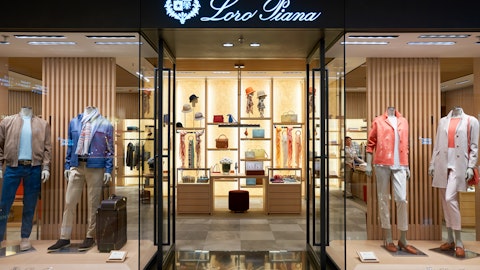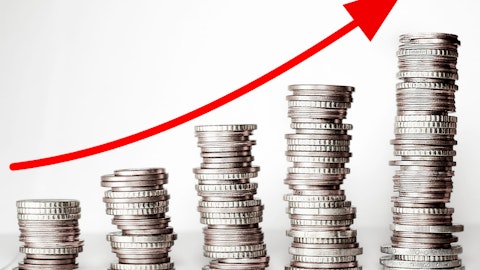People are looking for that. People are going out more, and they’re obviously wanting that kind of clothing as they — as part of their wardrobe. They’re looking in their closet, and they don’t have that product. So we’re going to fulfill that.
Matthew Boss: Great. And then, Jill, on gross margin, what do you see as the right long-term gross margin target for the business? I think your guidance this year implies you exceed the 36%, 37% target for the year?
Jill Timm: Yes. I would say we — obviously, we’re exceeding it. So we feel good. I think the algorithm to get to 7% to 8% is still really dependent on our top line growth, and that’s where we have to continue to focus what you’ve heard a lot from us today and why we believe we can get back to growth. On the margin side, we did say 36% to 37%. We’re exceeding that. So I would say, I think we can stay a little above 37% moving forward. I also would say our SG&A costs have risen a lot since the algorithm came in, in terms of wage inflation. So between the two, it still balances out to get us to the 7% to 8%, but I would say that our algorithm will be more margin-based based on the experiences that we’re seeing. A lot of that benefit coming through from the inventory management discipline that we’re seeing, so inventory being down 10%, continuing to plan it down mid-singles, taking our terms or clearance markdowns much more timely.
This is less markdowns but more timely markdowns, so they’re not as deep as well. And just having more choice rather than being so deep is also something that helps our turns. And so I always look back when we turn fast, we run some of our best operating margins. So that’s really the focus on what’s going to be a key driver from a margin perspective. And then from an SG&A perspective, we continue to do what we can do, obviously, from a cost discipline. Felt good we are down this year in our SG&A despite our 53rd week. So we’ll continue with that discipline. And with the top line growth, we’ll continue to make progress despite just a little bit of a step-back this year with the legislative change towards that 7% to 8%.
Operator: Our next question comes from Dana Telsey at Telsey Advisory Group.
Dana Telsey: Can you hear me okay?
Jill Timm: We can hear you now, Dana.
Dana Telsey: Good. Perfect. So nice to see the improvements and certainly a lot of the initiatives. Tom, when you think about the private brands, how are the private brands doing? And with the new Babies R Us that’s coming in, what does that replace in the store? And then just speaking about the stores, you had once talked about potentially even opening a couple of stores. How do you think of the store base today and the CapEx investment, whether in remodels, given the improvement in the store base? What are you thinking about in terms of that investment?
Tom Kingsbury: Well, we feel good about private brands. As far as private brands as a percent of total, it will probably go down a little bit because we’re working really hard on delivering more and more national brands. But it’s a product that delivers a lot of value on the selling floor. And that’s obviously really key. But we are moving forward faster. We’re trying to bring in more national brands overall. But we really — private brands are critical to our success, and we’re going to keep delivering that kind of value for a long time. Babies R Us, we have a lot of space, as Jill said, in our stores. And it’s going to be part of the infant/toddler presentation. So we’re just going to carve some space out. It’s about 1,500 square feet.
We have 1,500 square feet in the store that we can definitely utilize overall. So it’s not really going to displace anything. Again, we’re going to continue to reduce our inventories, mid-single digits for the foreseeable future. And we’re going to have plenty of space. We’re not worried about that at all. New stores, right now, we have five or six stores that we’re opening. That’s probably going to be our cadence for now. We’re still working on what the smaller stores are going to look like. But as far as remodels, one of the benefits of Sephora is we were able to touch stores. We have Sephora in 910 stores of our 1,200. So a lot of those have already been touched because of Sephora when we made the move to clear out the space for Sephora.
Do you have any comments, Jill, on the…
Jill Timm: No. I would just say a couple of things on the — a lot of what we’re talking about, including Babies R Us, is touching white space opportunities and leveraging and increasing store productivity. And that’s really what our goal is. Obviously, we’re excited. We ran our best store comp since 2010. So that’s a pretty good accomplishment that that’s working in the right direction. In terms of store openings, you know we have an incredibly healthy store base that we feel great with the fleet we have. And I think over the long run, we do believe there’s more store opportunities. But in this case, like Tom mentioned, we just have to figure out what that box needs to look like once we get a lot of these initiatives in flight.
So I would say, our CapEx this year is still assuming we’re going to touch some of those stores from a refresh perspective with the Sephoras, but we’re able to keep that always in the $500 million of CapEx. And then our CapEx will elevate if we decide there’s this new store opportunity. But at this point, we feel really good with where we’re positioned for ‘24.
Operator: We’ll take our final question today from Chuck Grom at Gordon Haskett.
Charles Grom: I appreciate all the color this morning. Jill, can you just touch on the composition of your comp in the fourth quarter between traffic and ticket and then, as we look ahead, how you’re planning the 0% to 2% from a similar perspective?
Jill Timm: Sure. I think from the fourth quarter, and quite honestly, our biggest issue from comp perspective has been traffic. And so a lot of what you’ve heard about today on the initiatives is how do we continue to drive discovery and excitement to drive traffic, and our ticket has been relatively flat to up. We’ve driven higher AURs as we brought in new brands and especially with Sephora, a little bit higher ticket, Tommy Hilfiger, et cetera. So our wallet share has stayed and our transaction has stayed flat to up slightly. It’s really been around our traffic that’s been down, and that’s been pretty consistent. So a lot of the initiatives that we’re focused on is how we can drive that discovery, so they want to come in and see newness.
It’s having more choice count. It’s having less depth. It’s having that fashion setting a lot quicker, and we’re going to be in and out. So there’s newness for them to come in and see. I would say that’s exactly how we’re approaching it this year is the difference between the negative and positive having an improvement from that traffic perspective. We’ve consistently can see the ATV being up slightly. We expect that to continue, but the improvement is going to come with traffic through all these new brands, these new initiatives that we have landing. Particularly around impulse and gifting, it’s giving them reasons to come in and then adding into their basket. So we feel like we’re positioned well to achieve that.
Charles Grom: Okay. Okay. That makes sense. And then the second question is just on the gross margins. And just to dovetail Matt’s question earlier, at this point, your gross margins would be up over 37%. That hasn’t happened in a long time. And I’m curious the thought process on reinvesting some of that margin back into price. You talked about the success that you had in the back half of last year in the high-volume pricing with some of the private brands. I guess why not invest more in gross margin to drive the traffic? Just curious the thought process there.
Jill Timm: So we did roll out all of our high-value pricing as we stand today. So it is about really value, particularly on those private brands. That’s what they stand for, and we’re continuing to drive that. I would say one of the things that we’re using, and this is a place that we’re moving into more automation around, is our pricing strategies and really making sure that we’re competitive. We’re using elasticity miles. We’re figuring out how to price that. So it will drive more from a customer perspective. I would say the benefit we’re getting is more around targeted coupons, targeted promotions. Some of the offers that we are giving weren’t as productive, and now we’re really going to focus it on the customers that will drive the productivity.
That’s one. Two, like I mentioned, and I don’t think I can say it enough, but all my merchant friends listening, it’s inventory management and inventory discipline, faster turns, having to take less deep clearance. Less clearance is a huge driver for us as well. And so bringing in that newness and selling more reg price is a benefit to margin. So I would say, we’re very keen on pricing. Value has been a core tenant of Kohl’s since it’s been started, and it will continue to be for us. We think that’s a space that we play incredibly well in. So we aren’t really driving margin and my opinion at the cost of taking prices up. We’re driving margin based on the disciplines that we put in and just the learnings through a lot of the elasticity modeling that we’ve been able to put in, in the last couple of years as well.
Charles Grom: Okay. Great. And then one for Tom. Just where are you guys on the journey to get younger with your customer base? You talked a little bit about the success you have with Sephora. Clearly, Babies R Us is going to help you. But I think that, that journey and where you are is an important thing to keep in mind. So just anything you can share and where you think you can get to over the next several years.
Tom Kingsbury: Well, again, as you mentioned, I mean, we’re making great progress in that journey. Sephora is really helping us out a lot. The Babies R Us also, as I mentioned earlier, part of that strategy. And then building on our junior business, rebuilding our accessory business overall, even the home decor business, we really feel that, that’s a younger consumer, overall. So I would say, we made a lot — we made good progress in 2023, but we’re going to continue to push hard because obviously, we want to be more attractive to the younger consumer. The Kohl’s brand also is part of that strategy as well. So we’ve got a lot of things working in order to have that younger customer come into our stores. So thank you.
Tom Kingsbury: Thanks, everyone. Really appreciate it, and have a great day.
Operator: And this concludes today’s conference call. Thank you for your participation. You may now disconnect.





